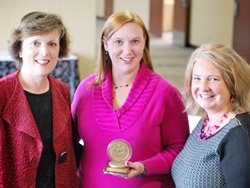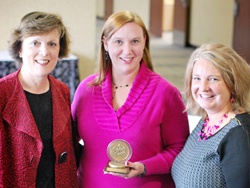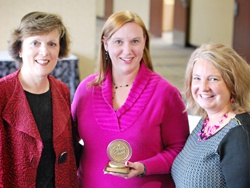


Whirlpool Corporation's Clyde Operations was recently recognized by The Bob Pike Group for its intentional and effective implementation of participant-centered training design and execution that increased retention and improved their company's bottom line.
In May 2013, the Clyde's health, safety, security (HSS) department took a major leap in the development of its team members when a group of 16 attended a local train-the-trainer boot camp put on by The Bob Pike Group that presented an interactive way of training that was more enjoyable and resulted in greater results than training through lecture alone.
During the training, trainer Priscilla Shumway, said "'the person who is doing the talking is the person doing the learning.' I had never thought about it that way before. We all kind of thought that if you had a subject matter expert [SME] 'preaching' that was the best way to deliver the message," said Jennifer Lenhart, one of Whirlpool's trainers who nominated the group.
After the boot camp, the 16 made a commitment to avoid the "flavor of the day" syndrome and make these changes in training methods stick.
"As we look back at what Whirlpool culture was, the training style was didactic—death by PowerPoint. A lot of 'prisoners' going to training," Lenhart said. "Whenever we specifically mentioned health and safety training, people knew they were going to be in a dark room for 45 minutes and were going to check out."
A group of more than 60 trainers at Whirlpool were tasked with delivering a class for information related to Globally Harmonized System (GHS), an Occupational Safety Hazard Administration regulation. "With 3,500 employees here, it was a perfect opportunity to do something different and show the whole operation how we can change things," Lenhart explained. First, the group started with changing the ambiance of the room.
They purchased bar height tables and removed all chairs from the room. They also redesigned their PowerPoint slides to make them more engaging and visually appealing with fewer words and less text. Lastly, they added music to the room so as learners entered, the whole atmosphere was completely unlike any prior training experience they had had at Whirlpool. "I didn't have to tell them it was going to be different. They knew," Lenhart said.
After that initial group had gone through the new GHS/OSHA training, the buzz hit the floor relatively quickly, that you didn't even need a chair because you didn't have time in the class to sit and be bored. The training team had incorporated four activities into the 45-minute session to get learners talking about the subject instead of just listening to a lecture and revisiting content instead of having an instructor repeat him or herself as review.
The content had also had been broken into smaller, more palatable chunks and learners were interacting with the content in small groups. Because of the flurry of activity, "they didn't even realize they were learning and teaching themselves," Lenhart said. Even some of the more skeptical employees were engaged. "It made me smile. We were on the right track. If [the skeptics] learn how to apply something differently, we've won. We've deployed something that can stick."
After GHS training, the classes on hearing conservation and personal protection equipment [PPE] were modified to be more participant-centered and interactive.
"When selecting trainers for this session, we not only utilized the trainers from our [OSHA] training, but also sought employees that do the jobs daily. We actively sought material handlers, press operators, and assemblers to help lead training. They participated in our train-the-trainer sessions prior to assisting training sessions and were also paired with another trainer as a development opportunity," Lenhart said.
Throughout April, May, and June 2014, over 175 sessions were completed by 58 trainers. "One of the most talked about activities within this training was the application of learnings by selecting appropriate PPE for the situation. A picture of a work area was put up on the screen, and participants had to select the appropriate PPE and put it onto a cardboard cutout of one of eight leaders in the building."
As a result, people were asking better and higher-level questions, Lenhart said—questions that aren't just "Do I have to?" but "What kind of hearing protection is best for this task?" "I hear folks asking 'this kind of hearing protection is more comfortable for me, but I'm not sure it has the right noise reduction rating for me.' And these are things we covered in training; it makes me smile that now they are asking the same questions we ask," Lenhart said.
Since that time, health and safety training has changed significantly along with small group meetings and even one-on-one interactions.
An unexpected outcome of this type of training was the informal mentoring that has become part of the Whirlpool training culture. "Following our initial training of the 16, we began holding regular check-in sessions to find out what was working, what wasn't working, where we needed more help, and how we could spread the use of participant-centered learning techniques.
"Since we have added to our ranks of team members that have attended The Bob Pike Group training, both Train-the-Trainer Boot Camp and Coaching for Success, we have invited them to our regular check-ins" which are quarterly, but employees are pushing for more frequent electronic communication and homework that can start discussions. The group is also beginning to informally mentor those that have been training, but have not been through the more intensive class," Lenhart said. "Very informally, in a homegrown mentoring way, a lot of them have started to pair off in groups of two or three and helping each other. It's been pretty neat. Something I didn't expect."
"We are currently in the process of working through other health and safety training topics as well as training sessions from our human resources group and continuous improvement team. The ability for us to really harness the limited time that we often have with employees to transfer learning has been realized through the use of participant centered learning."
With the new training methods, subject matter experts who are not trainers are volunteering to use the new methods to train peers on the relevant topics because they aren't expected to just go in and read slides anymore. The flow is more conversational and interactive. "Now they see themselves more as a facilitator and not a trainer," Lenhart said.
This spurred the HSS department to find people in each department who were not only passionate about training and being facilitators but were also leaders. With this new training method, these 10 to 12 people per department are now fitted with new tools that allow these departments to train on a more flexible timeline and on the spur of the moment if there is downtime.
"As we kind of stood back, and looked at all of our training...the impact of learning was so much greater than how we were doing things before. We weren't doing training with them; we were doing it to them."
"The beginning was painful, but a year later, it's fun to see how things have been transformed, how things are different here," Lenhart said. "Through our success here in Clyde, we are not only making a difference in providing better learning to our employees but also helping them make a difference here in the workplace."
The four recipients were formally recognized at an awards luncheon at The Bob Pike Group's annual creative training conference in Minneapolis on September 24, 2014.
The Pike’s Peak Performance Award is a formal recognition of trainers or organizations who have transformed their training by implementing participant-centered, results-based techniques championed by Bob Pike. These techniques involve participants in their own learning instead of relying on an instructor-led, lecture-based format. The award recipients have demonstrated improved retention and training transfer in their sessions by implementing these methods as well as an increased tie-in to business objectives.
Don't miss out on updates and chances
to sharpen your skills with participant-centered learning.




3740 N Chestnut St #113 - Chaska, MN 55318-3053